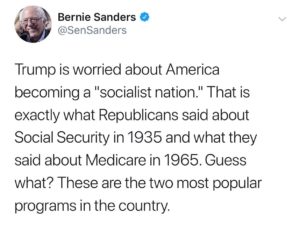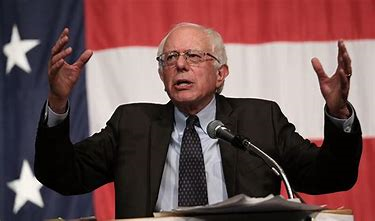A new financial analysis finds that Medicare for All, a bill (S 1804) introduced by Sen. Bernie Sanders in 2017, is not only financially viable, but that it could provide health care for all Americans and reduce health care spending by $2.93 trillion over the current system.
The report, entitled an Economic Analysis of Medicare for All, by Robert Pollin, James Heintz, Peter Arno, Jeannette Wicks-Lim, and Michael Ash of the Political Economic Research Institute (PERI) at the University of Massachusetts, Amherst, found that the current health care system is overly expensive compared to other developed nations, delivers lower quality care and prevents about 9% of the population from receiving health care because they cannot afford it.
“As of 2017, the U.S. was spending about $3.24 trillion on personal health care—about 17% of total U.S. GDP. Meanwhile, 9% of U.S. residents have no insurance and 26% are underinsured—they are unable to access needed care because of prohibitively high costs. Other high-income countries spend an average of about 40% less per person and produce better health outcomes. Medicare for All could reduce total health care spending in the U.S. by nearly 10%, to $2.93 trillion, while creating stable access to good care for all U.S. residents,” the report said.
In short, the study found that Medicare for All could cover everyone in the U.S. with no copays and cut overall health spending by almost one-fifth. This would be accomplished at a savings of about $2 trillion less than what Americans are spending today.
The 200-page report, which was reviewed by 12 academics, economists, doctors and public health policy experts before it was released, covers Universal Health Care and Health Outcomes; Demand Increases and Costs of Universal Health Care; Cost Saving Potential under Medicare for All; Financing Medicare for All; Budgetary Impacts on Businesses and Families; The Transition into Medicare for All; and the Macroeconomic Impacts of Medicare for All.
As presented in the original Sander’s bill, Medicare for All would provide U.S. residents with “decent health care as a basic right. “The analysis said this would be accomplished by “establishing a health insurance system that covers all residents in a manner comparable to the coverage now provided for residents 65 years old and older under the existing Medicare program. All health care consumers will also have the right to receive care from the providers of their choice.”
Medicare for All Would Save Money
The analysis also found that overall U.S. health care costs could fall by “about 19% relative to the existing system.” The biggest sources of cost saving will be in the areas of administration (9% savings in total system costs); pharmaceuticals (6% savings in system costs); and establishing “uniform Medicare rates” for hospitals, physicians, and clinics. This would generate a 3% savings in system costs. In the first years of the Medicare for All program, money would be saved by reducing fraud and waste.
Funding Medicare for All
Paying for Medicare for All would come from four primary sources, the analysis said:
- Business health care premiums would be cut by 8% relative to existing spending per worker. This would generate $623 billion in revenue.
- A sales tax of 3.75% on non-necessities. There would be exemptions for food and beverages consumed at home; housing and utilities; education and non-profits. Net worth tax of 0.38 percent would produce and estimated $193 billion in revenue.
- A net worth tax of 0.38%, with an exemption on the first $1 million in net worth. This tax would apply to only the wealthiest 12% of U.S. households and would produce $196 billion in revenue.
- Taxing long-term capital gains as ordinary income. This would produce $69 billion in revenues.
Who Objects to Medicare for All? Easy. Just Follow the Money

In a January 2019 interview, Robert Pollin, a co-author of the study, said hospitals and doctors would benefit under a Medicare for All program. “The doctors and hospitals are going to come out fine. We spend a lot of time showing that, yes, we’re going to lower their rates by about 7%. On the other hand, they are going to also save on their administrative time. …So if we cut their rates by 7% on average, but their administrative time goes down by 8%, that means they have 8% more time to see patients and bill for their time with patients. On balance, they’re going to come out okay,” Pollin said.
He also expected stiff opposition from private health care insurance and the pharmaceutical companies. This is because what “we’re talking about basically the euthanasia of private health insurance. They will oppose Medicare for all massively. The only way to deal with that problem is to fight against the opposition,” Pollin said.
Pollin is correct. A study by the Center for Responsive Politics, as reported in Open Secrets, found that congressional Democrats, who would be most likely to support this proposal, voted in direct response to how much money they received from the health care and pharmaceutical lobbies. This study found that Democrats who were not co-sponsors of the Medicare For All bill were paid 146% more money from health insurance companies between 2011 and 2016 and 60% more from the big pharma lobby.
Not surprisingly, Senate Minority Leader Chuck Schumer (D-NY) was paid the most by health insurance companies and ranks third in donations from pharmaceutical companies between 2011 and 2016. Schumer did not support the bill.
House Minority Whip Steny Hoyer (D-Md) took the most donations from health insurance companies and second most from pharma in his caucus between 2015 and 2016 and does not support single-payer, OpenSecrets said.
“Perhaps next to Wall Street, the pharmaceutical industry is the most powerful political force in this country. They have spent more than $4 billion on lobbying and campaign contributions over the past 20 years. The time has come to say enough is enough. The American people are begging us to take real action to end the greed of the pharmaceutical industry. Americans should not be paying the highest prices in the world for prescription drugs,” according to Senator Bernie Sander (Ind-Vt.)
Limited Media Coverage of the Report
PERI’s financial analysis of Medicare For All addresses one of the biggest drains on the nation’s finances. The U.S. spends 18% of GDP, $3.3 trillion, on health care, while Germany, France, UK, are paying between 9% to 11% of GDP for health care and have better health outcomes than the U.S. Yet, while this report shows this health program is financially viable, it has not been picked up by major media outlets. Why not?
One reason may be that PERI comes from a distinctly moral perspective with a mandate to engage in “research and policy addresses the impacts of globalization, unemployment, financial market instability, central bank policy, living wages and decent work, the economics of peace, development, and the environment.” In short, PERI may be academically based, but it has a politically progressive bent.
These are not values shared by the corporate media, so it is not surprising they would choose to cover this research. Still, the analysis provides more evidence that Medicare for All (S1804), proposed by Sen. Bernie Sanders, was not a socialist financial pipe dream, but has a solid financial foundation based in real politics.











